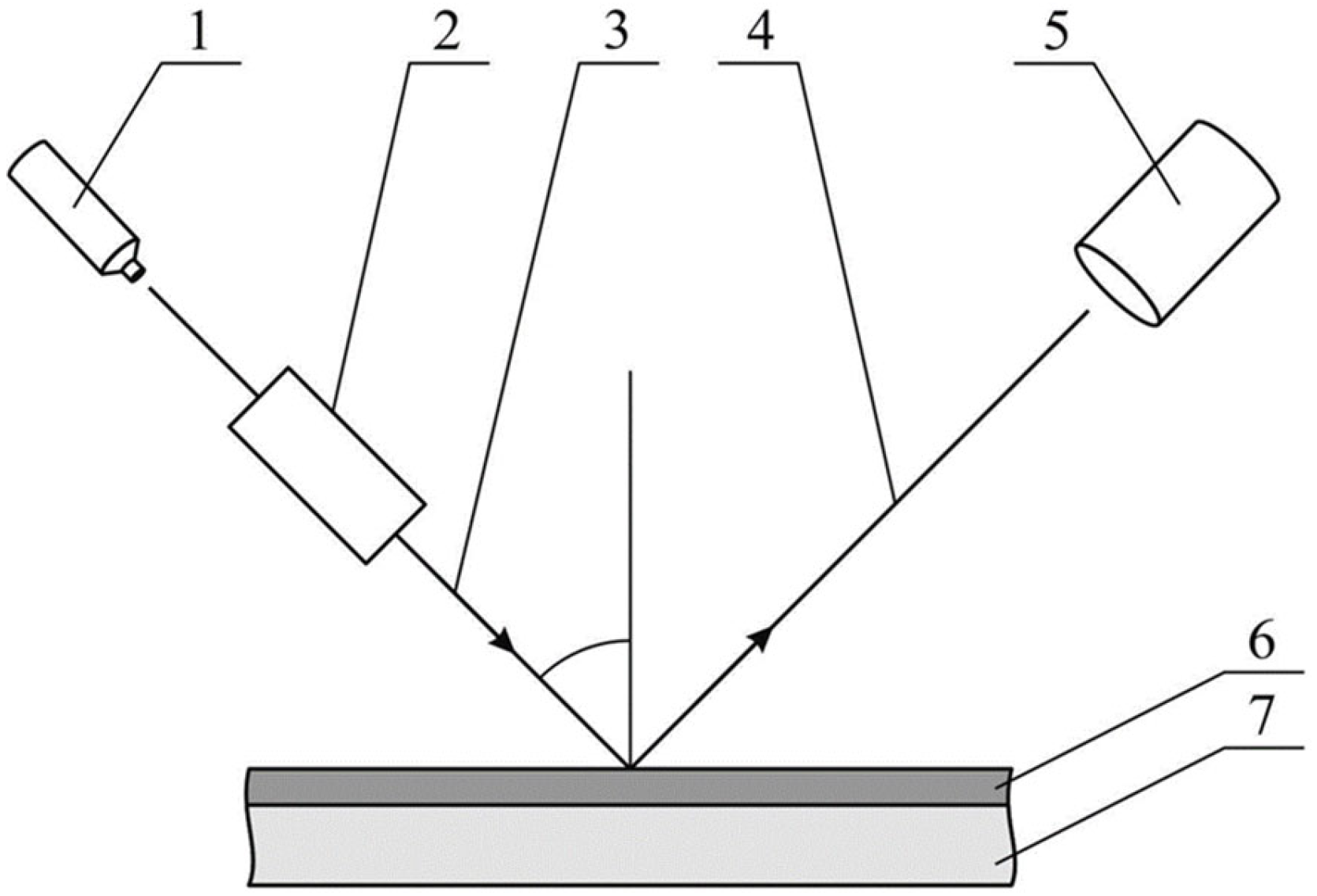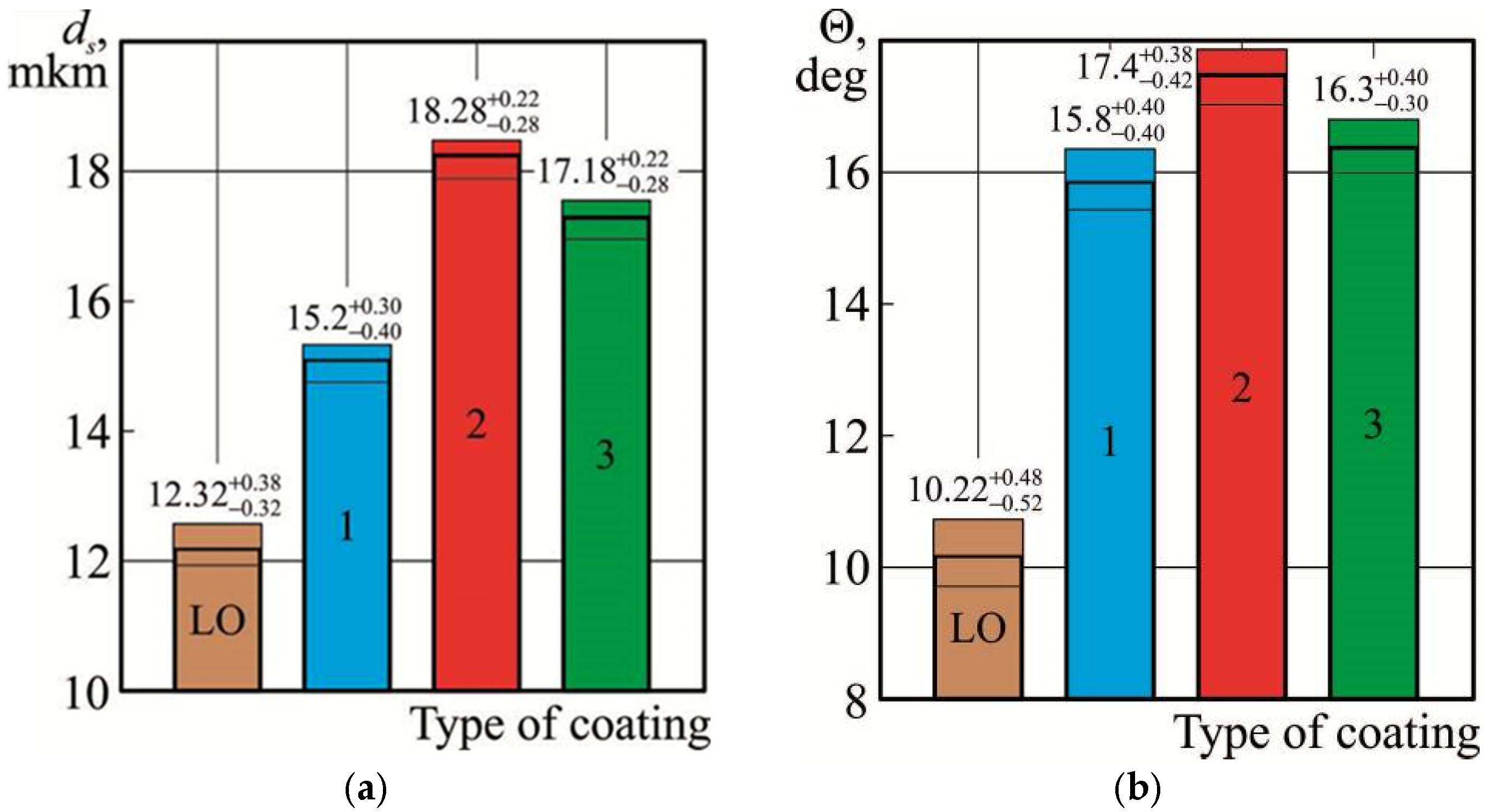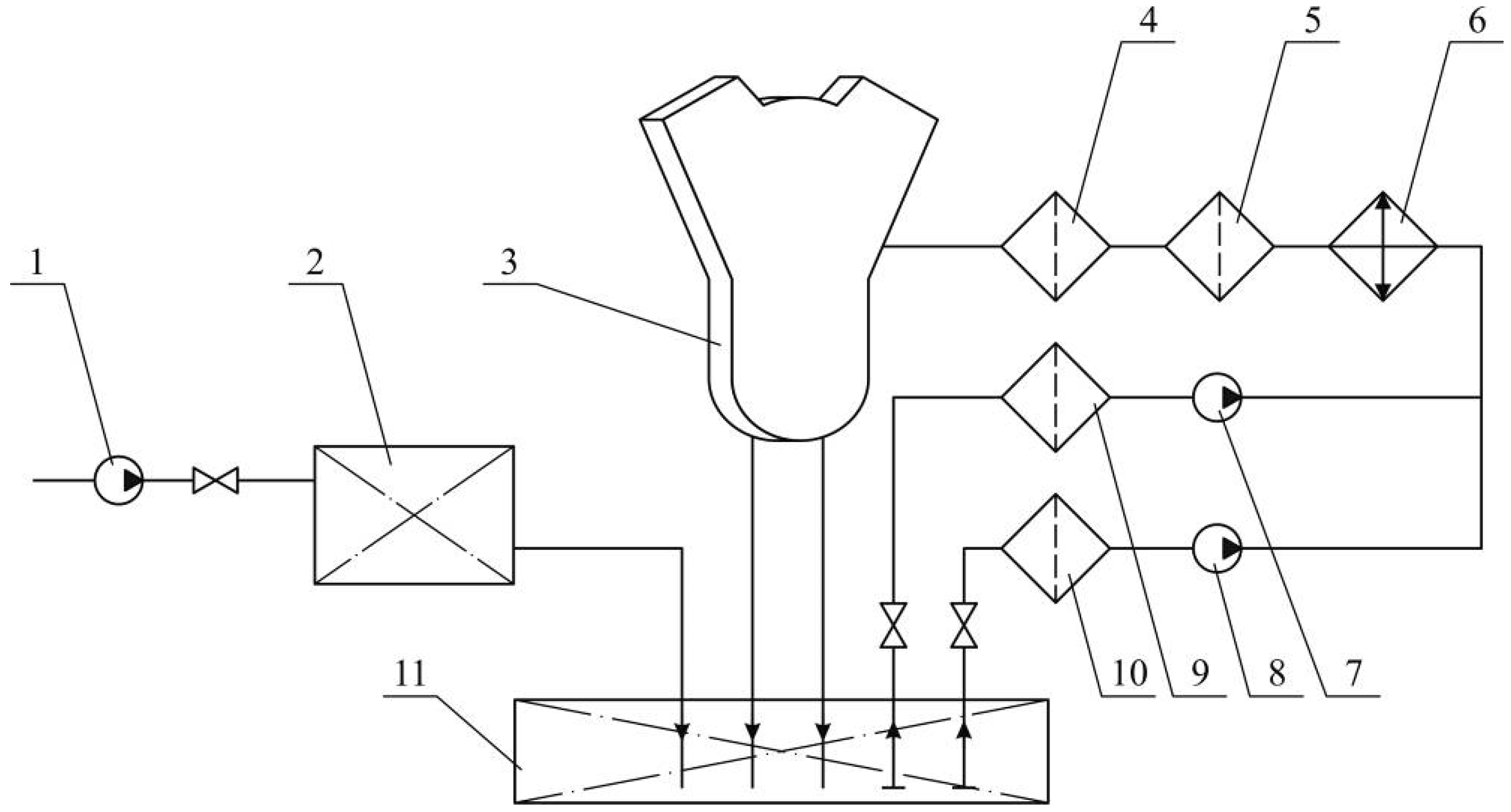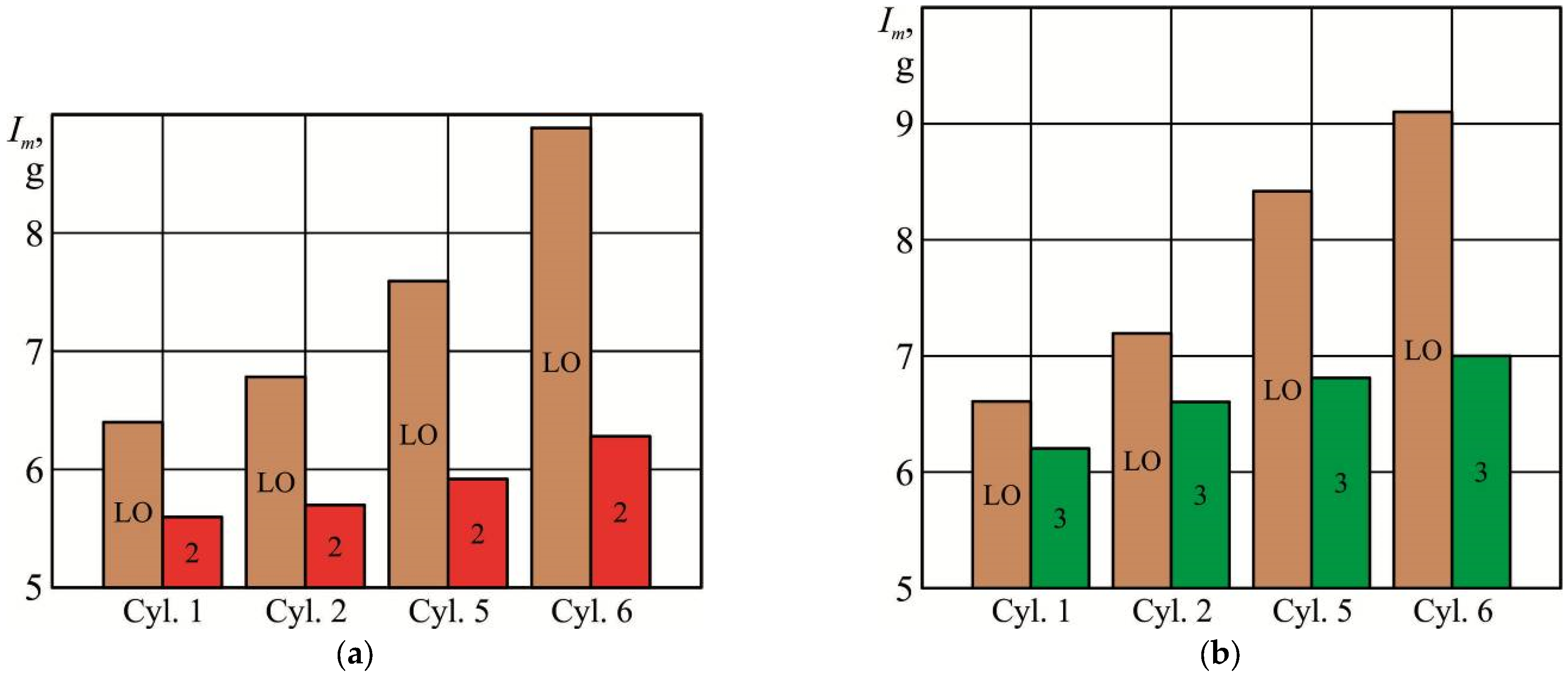1. Introduction
Internal combustion engines are the most common types of heat engines. They are used to convert the kinetic energy of gases that are formed in their cylinder during fuel combustion into shaft torque and then into useful work. Internal combustion engines are installed on various automobile, rail, and sea transport vehicles, ensuring their efficient use [
1,
2,
3].
The functioning and operational reliability of internal combustion engines are provided by various systems [
4,
5]. The main ones are fuel, oil, cooling, starting air, and exhaust gases. These systems ensure the process of fuel combustion and exhaust of combustion products, as well as the lubrication and cooling modes of the main parts of the diesel engine.
The lubrication system, which can act as a lubricating or circulation system for marine diesel engines, provides the supply of lubricant to the main contact pairs of the diesel engine—piston ring–cylinder liner and bearing shell–crankshaft [
6,
7].
Low-speed marine diesel engines that operate on a two-stroke cycle are equipped with two lubrication systems. The lubrication system supplies oil to the diesel cylinder; the circulation system supplies lubricant to the frame, crank and crosshead bearings, gear or chain transmission, and piston cooling. Each system uses its own grade of oil, which differs from each other in performance characteristics (primarily in alkaline number, viscosity, and flash point) [
8,
9,
10].
Marine diesel engines that operate on a four-stroke cycle have a common lubrication system and use one grade of oil. Lubricant is supplied to the bearings of marine diesel engines by a circulation lubrication system. In this case, oil is supplied through special holes in the crankshaft to lubricate the frame and crank bearing, and through a hole in the connecting rod to lubricate the head bearing [
11,
12]. In this case, lubrication of the cylinder liner is achieved by spraying oil from the diesel crankcase (
Figure 1).
The technical condition of the individual units or parts of internal combustion engines (diesels) plays a decisive role in ensuring their reliability and accident-free operation [
13,
14,
15]. Some of these parts (relative to marine diesels) are sliding bearing inserts, which bear normal and radial loads in the crank-connecting rod mechanism [
16,
17,
18]. The long-term and stable operation of sliding bearings in marine diesels is impossible without the use of a lubricant, which is a component of the friction triad metal (bearing insert)–lubricant (oil)–metal (diesel shaft) [
19,
20,
21]. This ensures a hydrodynamic or boundary lubrication regime. A brief absence of lubricant in this triad or violation of the lubrication regime leads to a sharp increase in wear of the bearing inserts and can cause a diesel accident [
22,
23,
24].
In addition, the deterioration of the technical condition of the bearing inserts in marine diesels (associated with an increase in the wear of their surfaces) is the cause of an increase in gaps between the shaft and the insert [
25,
26]. This leads to an increase in dynamic loads [
27,
28], the occurrence of shaft beats [
29,
30] and an increase in the wear of the bearing inserts [
31,
32,
33]. Metal particles (which are products of wear of the bearing inserts) spread through the diesel lubrication system, increasing the mechanical impact on the diesel parts, primarily on the other inserts, as well as the cylinder liner and piston rings [
34,
35,
36].
The lubricating oil in the bearing liner–diesel shaft connection provides hydraulic tightness and prevents the direct contact of this friction pair. The increase in hydraulic tightness is facilitated by surface tension forces that arise on the surface of the lubricating film upon contact with the air phase. The magnitude of these forces is proportional to the value of the contact angle θ (
Figure 2).
Increasing the contact angles both on the open surface (at the metal–lubricant–air interface) and inside the friction pair (at the metal–lubricant–metal interface) contributes to an increase in the surface tension force, a decrease in lubricant leakage, and an increase in the bearing capacity of the lubricant layer [
11,
37,
38]. All this has a positive effect on the technical condition of the bearing liners. Increasing the leakage in the liner–shaft connection reduces the damping properties of the lubricant, which can lead to the increased wear of the bearing liners and an increase in lubricant consumption for burnout. At the same time, due to an increase in the friction force between the surfaces that come into direct contact, mechanical losses increase, and the effective power of the diesel engine also decreases [
39,
40,
41]. Gradually, this contributes to a deterioration in the technical condition of the bearing surfaces, which can become one of the causes of an emergency.
Thus, maintaining the technical condition of the bearing liners in marine diesel engines (which can be ensured by increasing the wetting angles of the oil film) is a relevant scientific and applied task. Its solution helps to reduce mechanical losses, as well as dynamic and thermal loads on the main parts of the diesel engine.
3. Materials and Methods
Research to determine the influence of organic coatings (epilams) on the technical condition of marine diesel bearing inserts was carried out in the following sequence:
Development of technology for applying epilams to the surfaces of bearing inserts;
determination of the thickness of the epilam nanolayer adsorbed on the metal surface of the bearing inserts;
study of the influence of the epilam nanolayer on the formation of the oil boundary layer;
determination of changes in the technical condition of bearing inserts in case of applying a nanolayer of epilam to their surface.
During the experiments, the following epilams were used: Aqualin, Efren-K, and Polisam-20, which have a maximum operating temperature of 450 °C and allow for short-term operation up to a temperature of 700 °C. Further in this article, epilams are arbitrarily designated as 1, 2, 3. The technology of applying epilams to the surface of bearing inserts consisted of the following: Experiments were carried out for a new set of inserts. Initially, their degreasing was carried out in ozone-safe freon-116 (C
2F
6) by volume immersion, followed by drying. After that, at ambient temperature, direct epilamization was carried out by immersing the inserts in the epilam. To determine the thickness of the epilam layer, which was adsorbed on the surface of the bearing insert, and the thickness of the oil boundary lubricating layer, which was formed on the surface of the epilam, preliminary laboratory studies were conducted. As an analogue of the bearing insert surface, a polished metal surface was used, which was covered with a layer of epilam by volume immersion. The time of the metal surface being in the volume of the epilam varied in the range of 2–10 min, after which the surface was dried at a temperature of 20 °C. The thickness of the epilam layer, which was adsorbed on the metal surface, was determined on an ellipsometric installation; the principal scheme of this is shown in
Figure 5.
Ellipsometry is one of the most common methods for determining the thickness of thin layers of liquids (transparent for optical study) by analyzing the angles of light reflection from a clean surface and from a surface with a coating [
76].
The thickness of the epilam layer adsorbed on the metal surface, as well as the structural characteristics of the boundary lubricating layers (layer thickness and wetting angle), was determined using an ES01 spectroscopic ellipsometer (manufacturer Ellitop, Beijing, China). The ES01 ellipsometer is designed to measure the parameters of the layer structure (e.g., thickness) of single-layer and multilayer nanofilms, including their physical parameters (e.g., refractive index n, extinction coefficient
k or dielectric functions ε
1 and ε
2). The ES01 ellipsometer allows you to measure the thickness of thin adsorbed nanofilms in the range of 3–100 nm, with an accuracy of 0.2 nm, and determine the wetting angles in the range of 2–60 degrees, with an accuracy of 0.1 degree. In addition, it allows you to determine the thickness of the liquid layer in the range of up to 22–25 μm with an accuracy of 0.2 μm. The change in the technical condition of bearing inserts in the case of applying an antifriction coating (epilam) to their surface was carried out for the marine diesel 12V32/40 MAN-Diesel&Turbo. These diesels are some of the most common models of the MAN-Diesel&Turbo company (Augsburg, Germany) and are used both in marine, and in railway transport, as well as in stationary power installations (as generators of electric stations) [
77,
78]. Two diesels 12V32/40 MAN-Diesel&Turbo were installed on a specialized marine vessel that was designed for container transportation. The diesels transmitted their power through a reducer to one screw according to the scheme, which is shown in
Figure 6.
The diesels were operated at the same load, using the same types of fuel and oil [
79,
80,
81]. When operating diesels outside of special environmental areas, the Sulfur Emission Control Areas (SECAs) [
82,
83], RMG380 fuel (TFG MARINE PTE LTD, Ocean Financial Centre, Singapore) with a sulfur content of 0.048% was used. When operating diesels in SECAs [
84,
85,
86], DMA fuel with a sulfur content of 0.076% was used. Throughout the entire experiment, Castrol TLX PLUS 404 lubrication motor oil was used (Castrol, Pangbourne, UK).
The V-shaped layout of the diesel allowed the bearing inserts of one of the rows of diesel cylinders to be treated with an antifriction coating (epilam). At the same time, the bearing inserts of another row of cylinders were not treated with epilam. Thus, for each of the diesels, the bearing inserts of one row of cylinders (yellow and blue in
Figure 6) were treated with epilam, while the inserts of another row of cylinders (grey in
Figure 6) were not treated.
The final stage of the study was measuring the wear of the bearing shell surfaces, which was determined for each row of each diesel engine. For this purpose, Walcom LB3002 electronic scales (manufacturer Ellitop, China) were used, which allow measurements with a maximum weight of 3100 g and a resolution of 0.01 g.
Thus, the main methods used in the research were optical (which measured the thickness of the epilam layer adsorbed on the metal surface, as well as the thickness of the boundary lubricating layer and its edge wetting angles) and gravimetric (which determined the mass of the bearing liners before and after the experiment, as well as their wear).
4. Results
The research was conducted in a scientific laboratory (first and second stages) and on the diesel engines of a specialized marine vessel (third stage).
The first stage of the research involved determining the optimal time required to apply epilams to a metal surface, as well as selecting epilams that ensure the formation of boundary lubricating layers with the greatest thickness and contact angle of wetting.
Initially, the thickness of the epilam coating applied to the metal surface was determined using an ES01 ellipsometer. To improve accuracy, the thickness of the epilam layer adsorbed on the surface was measured five times for each time interval for each epilam. After that, the average value of the adsorbed thickness of the epilam layer was determined from all the obtained values. The values of the average thickness of the epilam layer, as well as the range of values obtained during the measurement, are given in
Table 1.
For better visualization, the changes in the average thickness of the adsorbed epilam layer (as well as the deviation of the values from the average value) are shown in
Figure 7.
As can be seen from the data provided (
Table 1 and
Figure 7), after 6–10 min of exposure to the solution, the thickness of the epilam adsorption layer on the metal surface stabilizes. In this case, the thickness of the epilam adsorption layer for different samples varies in the range h = 11.2–17.4 nm.
The objective of the second stage of the research was to determine the effect of epilams on the structural characteristics of boundary lubricating layers (layer thickness ds and contact angle θ). Castrol TLX PLUS 404 was chosen as the oil. This oil was used in the circulating lubrication system of the MAN-B&W 12V32/40 marine diesel engine. Using the ES01 ellipsometer, the characteristics of the boundary lubricating layer formed on a “clean” metal surface (without epilam coating) were initially determined. After that, the boundary layer thickness ds and contact angle θ were determined for the boundary lubricating layer formed on a surface with different epilam coatings. To ensure the required accuracy, these parameters were measured five times. After that, the obtained values were averaged.
The average values of the boundary layer thickness
ds and the contact angle θ, as well as the range of their changes, are given in
Table 2.
For better visualization, the change in the boundary layer thickness
ds and the contact angle θ (as well as the deviation of the values from the average value) are shown in
Figure 8.
Here, the designation LO (lubrication oil) refers to the direct thickness of the boundary oil layer ds, which forms on the metal surface, as well as the value of its wetting edge angles θ. Under the designations 1, 2, 3—the thickness of the boundary oil layer ds, which forms on the same surface when it is covered with a layer of epilam, as well as the values of the wetting edge angles θ.
As the results show, epilamination provides a 1.23 to 1.40 times increase in the thickness of the oil boundary layer (ds), as well as a 1.55 to 1.60 times increase in the edge wetting angle (θ).
The third stage of research was carried out on 12V32/40 MAN-Diesel&Turbo marine diesel engines. The schematic diagram of the circulating lubrication system is shown in
Figure 9.
The supply of lubricating oil to the circulation lubrication system is carried out by lubrication pump 1, which ensures the replenishment of lubrication tank 2 and the subsequent entry of the lubricant into the drain tank 11. The supply of lubricant for lubricating the parts of diesel engine 3 is provided by the circulation pumps 7 or 8, while the lubricant is subjected to preliminary cleaning in coarse filter 9 or 10. If necessary, the lubricant is cooled in cooler 6. Before entering the diesel engine, the lubricant is cleaned in the coarse filter 5 and fine filter 4.
Considering the results of the first and second stages of the research (results presented in
Table 1 and
Table 2 and
Figure 7 and
Figure 8), the third stage was conducted using epilams 2 and 3. These epilams ensure the formation of boundary layers with the greatest thickness and contact angles of wetting on the metal surface.
The operating time of the diesel engines (and, accordingly, the time of the research) was about 3200 h. During this time, the 12V32/40 MAN-Diesel&Turbo diesel engines operated in a wide range of loads—35–85% of the rated power. At the same time, all the necessary parameters were maintained in the cooling and lubrication systems, which prevented temperature overloads.
This stage of the research was carried out on 12V32/40 MAN-Diesel&Turbo marine engines. The bearing shells of one row of cylinders of the starboard engine were coated with epilam 2 (yellow row in
Figure 6). The bearing shells of one row of cylinders of the port engine were coated with epilam 3 (blue row in
Figure 6). Each engine had a row of cylinders with bearing shells that were not coated with epilam (grey row in
Figure 6).
To determine the impact of antifriction coatings (epilams) on the technical condition of the bearing shells after the regulatory service life of the bearing units, the wear of their bearing surfaces was assessed. For this purpose, the wear of the bearing shells was determined. The condition of the bearing shells that were not coated with epilam is shown in
Figure 10. The condition of the bearing shells that were coated with epilam is shown in
Figure 11.
The initial visual inspection of the bearing liners revealed an improvement in the technical condition of the liners, which were previously coated with a layer of epilam. This fact was established for both the starboard diesel engines (for which epilam No. 2 was used) and the portside (for which epilam No. 3 was used).
Wear of the bearing shell surfaces (and, accordingly, the deterioration of their technical condition), which were pre-treated with epilam, was observed only in the central part. This was the part of the bearing shell that was the most loaded and exposed to contact with the diesel shaft compared to the others. In this regard, the wear of this section of the bearing shell was considered standard and, in the case of acceptable values, not critical. The wear of the shell surface, to which the epilam layer was not applied, spread over a larger area and was also deeper. This indicates that, in this case, stronger contact interactions occur between the surface of the bearing shell and the shaft. The reason for their occurrence is a decrease in the thickness of the boundary lubricant layer, as well as a decrease in the wetting angles. These are the signs that are characteristic in the absence of an adsorption layer of an antifriction coating (epilam) on the surface of the shell.
Thus, a visual inspection of the bearing shell condition was an additional (in addition to weight) research method. At the same time, it allowed us to perform a preliminary assessment of the effectiveness of applying the epilam coating, as well as make assumptions about the advantages of using one epilam over another.
The main objective of bearing shell condition analysis was to assess the efficiency of the lubrication system. In this case, there were conclusions made about the quality of the engine oil used, as well as the correctness of the selected lubrication, cooling, and diesel engine load modes [
87,
88].
One of the most accurate methods for determining changes in surface geometry is scanning them with an electron microscope. Unfortunately, the use of such measuring equipment directly on sea vessels is still difficult. This is due to both the cost of such measuring devices and the need for specialists on board who are able to perform measurements and analyze them. In addition, the frequency of using an electron microscope on board a sea vessel is extremely low. Sending liners or other diesel units to determine their wear using the electron scanning method is connected with additional costs (for example, for a 12V32/40 MAN-Diesel&Turbo diesel, it is necessary to analyze the condition of 24 bearing shells). In addition, sending diesel parts to a research laboratory, as well as receiving the research results, takes a certain amount of time. This delays the decision-making time and the efficiency of the diesel lubrication system.
In this regard, an assessment of the bearing shell surfaces was performed by measuring their wear. For this purpose, Walcom LB3002 electronic scales (manufacturer Ellitop, China) were used, which allow for measurements with a maximum weight of 3100 g and a resolution of 0.01 g. According to the operating instructions for marine diesel engines, the weight of the bearing shells was 2850 g, which fully met the conditions for using the Walcom LB3002 electronic scales.
The weight of the bearing shells of the 12V32/40 MAN-Diesel&Turbo diesel engine before their installation on the diesel engine and after the operational period was measured by weighing them once. In both cases, before weighing, the bearing shells were cleaned of all contaminants and treated with cetyl alcohol C
16H
33OH. The results of bearing mass measurements are given in
Table 3 and
Table 4.
The wear of bearing liners (as an indicator by which the performance of the diesel lubrication system and the efficiency of using epilams were assessed) was determined as the difference in their mass before and after operation. The results of measuring the wear of bearing liners are given in
Table 5.
The percentage reduction in wear in the case of coating the bearing surfaces with various epilams can be estimated using the expression:
where
—the reduction in wear of the liner of the i-th bearing, %;
—the wear of the liner of the i-th bearing without a surface coating and with a surface coating with a layer of epilam, g.
The values obtained in accordance with the expression (1) for different operating conditions of the 12V32/40 MAN-Diesel&Turbo diesel engine are given in
Table 6.
Based on the results of
Table 6, diagrams were made that reflect the percentage reduction in wear of bearing liners in the case of covering their surface with a layer of epilam (
Figure 13).
Considering the uneven load on the different cylinders of the diesel engine, the technical condition of the bearing assemblies differs from each other [
89,
90]. This is particularly manifested in the unequal wear of the bearing inserts [
91,
92]. In this case, the bearing inserts of the cylinders located closer to the load consumer (propeller or electric generator) have greater wear compared to the inserts that are further away from the load consumer.
When conducting experiments, the wear of the liner for the “stern” bearing (for cylinder No. 6) was taken as 1; the wear of other liners was recalculated according to this value in relative units. The calculation results are given in
Table 7 and
Figure 14.
It should be noted that the results of determining the wear of the bearing inserts in different diesel engines (portsaid and starboard) in the case of applying epilams 2 and 3 to their surface, as well as when operating bearing inserts without applying antifriction coatings to their surface, have proportional values. This confirms the correctness of the theoretical assumptions and the accuracy of the measurements.
The method of epilamination, applied to ship bearings, has not received widespread distribution in the components of ship technical systems. This is, among other things, associated with the conservatism of marine power engineering as a science and the desire of the ship’s crew to avoid additional risks arising from the introduction of innovative ideas. This especially applies to such responsible nodes as ship diesels. However, with high-quality preliminary research, as well as compliance with the technology of applying epilams to surfaces, it is possible to create conditions that contribute to improving their operational characteristics and technical condition.






















